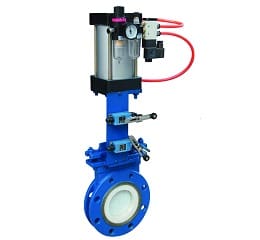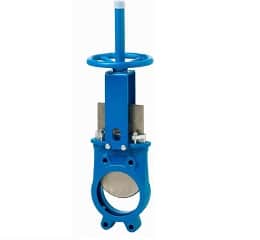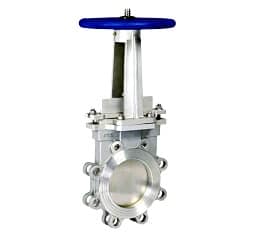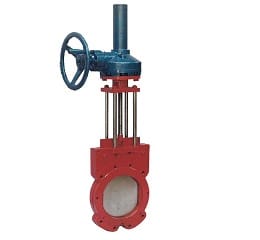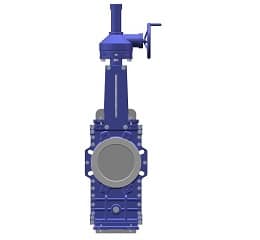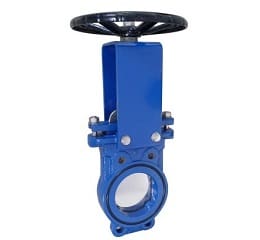Knife Gate Valve Manufacturer
Knife Gate Valve
In this article, we will learn about knife gate valves, their kinds, how they function, their distinctive characteristics, limitations, a selection guide, and a broad range of applications to help you choose the right type of valve for your requirements.
Valves are the essence of every process in today’s world. Can you imagine any system without valves? It seems next to impossible, right!
Choosing the right kind of valve for the right purpose is not rocket science anymore. However, you need to have basic knowledge of different types of valves. This article will provide you with basic knowledge about a special type of gate valve.
REQUEST A QUOTE FOR MORE DETAILS
What Is The Knife Gate Valve?
Knife gate valves are a kind of gate valve that is mostly used for full open or cutoff services in systems with a high suspended particles concentration. These valves are particularly advantageous for dealing with slurry, viscous, corrosive, or abrasive media.
As with a knife, the gate is very efficient in cutting through the medium and effectively breaking up any impurities present within the medium in the pipeline. Thus, completely eradicating the leakage phenomenon of the traditional gate valve in a medium with solid impurities.
These valves have a minimized pressure drop in a fully open position. Thus, they are easy to actuate. Knife gate valves also have a relatively low weight and are cost-effective.
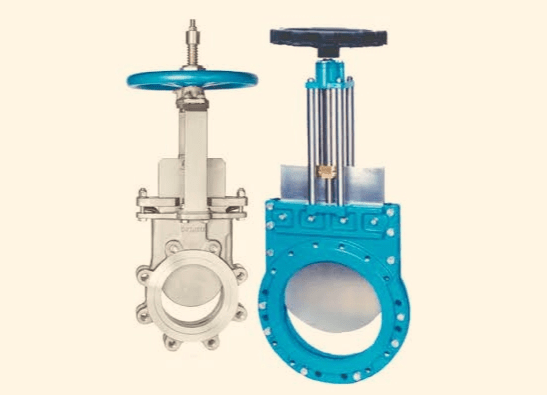
How Does The Knife Gate Valve Work?
Being a special type of gate valve, the working of the knife gate valve is similar to that of the ordinary gate valve with enhanced capabilities.
The bottom of the valve plate has an oblique incision, like the blade, This knife type of oblique incision can easily cut through the pipe flow medium. Thus, make the closing of the valve very easy and effective, even in the case of a semi-solid medium.
The driving mode of the knife gate valve is manual, pneumatic, and electric, and its working principle is very simple. So, taking the manual knife gate valve as an example, let’s find out the working principle of the knife gate valve.
The weir-type valve is one of the most common design of diaphragm valve used for small flow control with leak-proof operation. It is also referred to as a saddle-type diaphragm valve.
The weir-type has a raised lip on the body, which acts as a valve seat. The diaphragm comes into contact with the weir during valve operation to control the flow of fluids. In addition, the raised weir helps to reduce the diaphragm movement between the fully open and completely closed positions. This lowers the amount of stress and strain placed on the diaphragm during this process.
The valve design is ideal for hazardous or corrosive liquid and gas, as any membrane failure can be easily contained within the bonnet. Because of the self-draining characteristic of the valve body, they are also recommended for food processing applications.
Types Of The Knife Gate Valve
Knife gate valves are classified based on three main criteria.
- Material of the valve body
- Material of the seat
- Type of end connection
- Stem Movement
- Flow direction
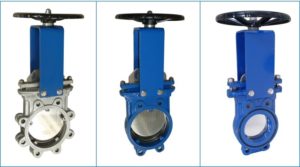
Classification Based On The Material Of Valve Body
Knife gate valves are made of a variety of metals and alloys. Three types of base metal are broadly used for the manufacture of Knife gate valves.
- Caste Iron Valves: used in high temperature and pressure applications.
- Stainless Steel Valves: used for corrosive, abrasive liquid applications like the chemical industry.
- Lined Valves: used for high-quality hygiene and cleanliness applications like in the food processing and beverage industry.
Classification Based On The Material Of Seat
- Metallic Seats: for low working temperature of the flowing medium (<100o F), Applicable for semi-solids only for better sealing.
- Resilient Seats: for high working temperature of the flowing medium (<400o F), applicable for semi-solids and powdered or chipped solids for efficient sealing.
Classification Based On The Type Of Connections
There are three different types of connections available as per design requirements.
- Wafer type knife gate valve
- Lugged type knife gate valve
- Flanged type knife gate valve
Classification Based On Stems Movement
- Rising stem: good ceiling space available.
- Non-rising stem: limited headspace.
Classification Based On The Direction Of Flow
- Unidirectional valves have seats on one side and cannot be used for reverse flow.
- Bi-directional valves have a “D” type seat and can be used for both forward and reverse flow directions.
Advantages Of Knife Gate Valve
• These valves are designed to support both uni or bidirectional flows, with soft or metal seats.
• A fully open valve provides a very low and smooth transition for the flow of the medium.
• The valve can be installed in any position. However, the stem should be perpendicular to the ground and the flywheel on the top.
• The knife gate valve self-cleans the material from the seat on each stroke of the valve blade. This feature built into the design improves overall valve life.
• Shorter valve length even for a large nominal diameter of the valve
• There are types and designs suitable for high-pressure flow.
• Easy and in situ maintenance and repair work is possible in knife gate valves.
• They are very helpful in wastewater applications where corrosion is a major concern.
• Knife gate valves are economically and conveniently available due to their versatile usage.
Disadvantages Of Knife Valve
• The knife gate valve price is higher than that of traditional gate valves, so the knife gate valve cannot completely replace the traditional gate valve.
• A knife gate valve with a single seat is designed to seal in one direction only. So the same valve cannot be used for bi-directional flow.
• It is not recommended to use these valves to regulate the flow because when fluid is pushed against a partially closed gate, vibration occurs, which leads to cavitations. And cavitations will eventually damage the seat and the body.
Knife Gate Valve Selection Guide
Knife gate valves are used in a wide range of applications. Generally, they are selected based on the following criteria:
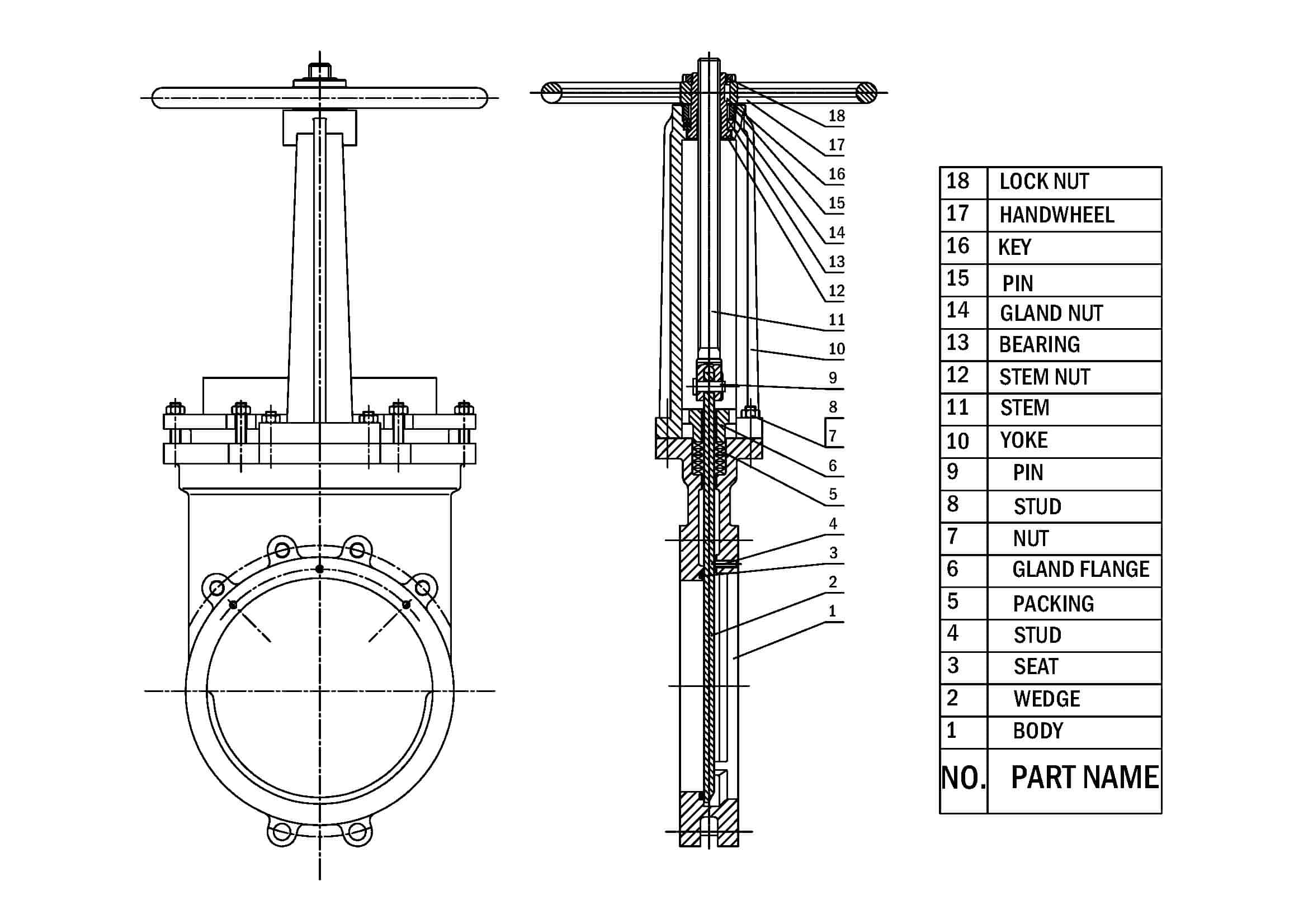
- Purpose: knife gate valves are used for full flow or complete shutoff of flowing medium in a process. However, this type of valve is a wrong choice in places where throttling or flow regulation is required.
- Unidirectional or bidirectional: Both types of flow are achieved by the different designs of the valve. One must be sure of the flow type to ascertain the type of valve required.
- Flowing medium, Pressure, and Temperature: The nature, pressure, and temperature of the medium govern the selection of the material for these valves. For example, knife gate valves are mostly used for high viscosity semi-solid or fine powdered flow medium.
- Connection fitting at inlet and outlet: One must be certain about which type of end connection is required (i.e., wafer, flanged, or lugged )
- Type of actuation required. (Manual or automatic). Manual actuation involves a simple lever or a gearbox and wheel arrangement. Automatic actuation may be pneumatic or hydraulic.
Where Is The Knife Gate Valve Used?
Knife gate valves are usually equipped with a sharpened blade to cut through extremely viscous liquids. They are especially used in the following applications:
- Knife gate valves are widely used in wastewater management to operate efficiently in a highly corrosive atmosphere.
- Knife made of acid-proof stainless steel is used in the chemical industry.
- Food processing industry
- Pulp and paper industry where the raw pulp is the medium.
- Sewage treatment plants where soils are the medium.
- Metal and Steel industry where slag and ash are the medium.
- Mining industry where powdered substances and slag form the medium.
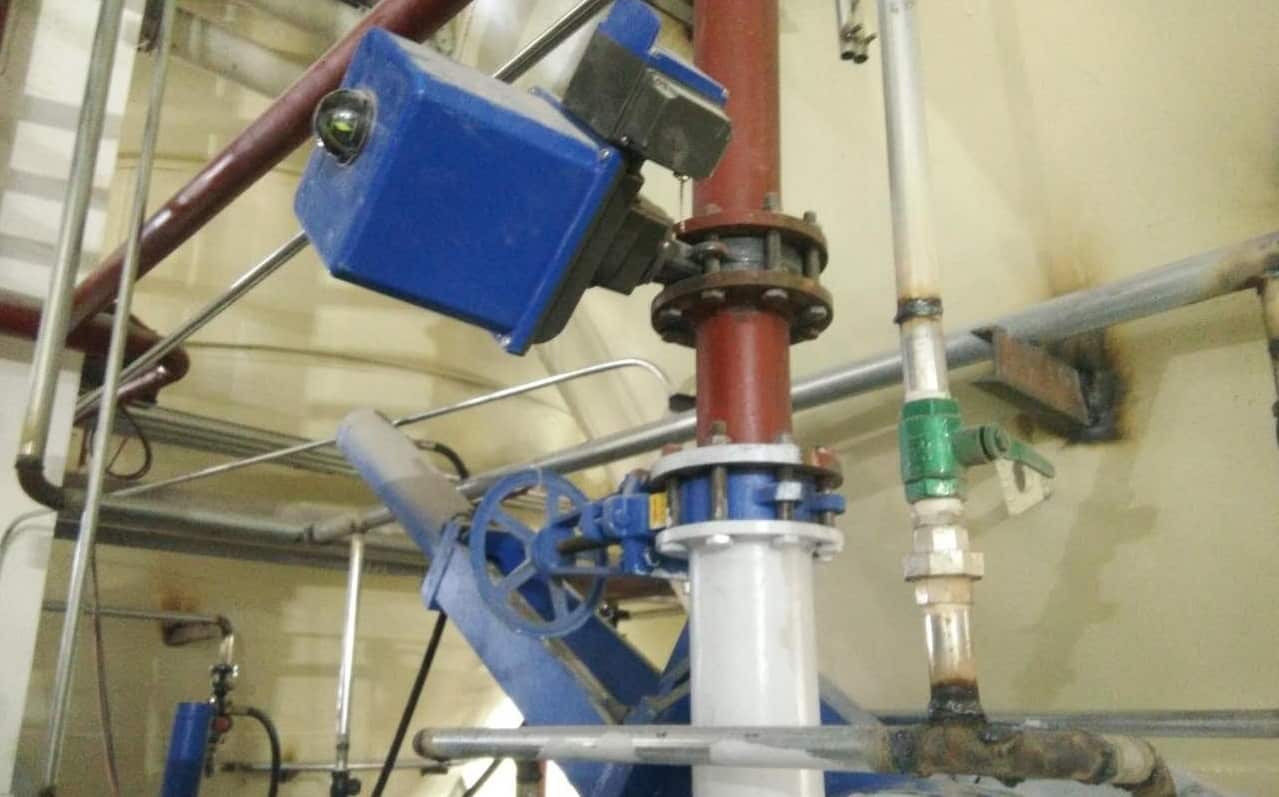
Apart from these examples knife gate valve can be used for any type of viscous liquid with suspended solids or powdered or granular solids within a low temperature and pressure range.
How To Install A Knife Gate Valve?
Caution before installation of the Knife Gate valve.
- If the valve is kept for a long period of time prior to installation, it should be stored vertically and, in a cold, dry location to avoid harming the packing.
- Before the commencement of any type of installation, maintenance, or repair work, any pipeline must be depressurized and well isolated.
- A knife gate valve with a single seat is designed to seal in one direction only.
- Valves with replaceable urethane, metal, or TFE seats. These seats are separate pieces that can be replaced easily whenever required. They are not attached to the valve body. The valve should be installed between two mating flanges before pressurizing the system.
- When installing the valve at the discharge end of a pipeline, a companion flange must be attached to the valve’s outlet flange to maintain the replacement seat. In addition, the knife gate valve should be opened slightly prior installing.
Step-By-Step Guide To Installation Of Knife Gate Valve
- Carefully inspect the valve and identify the seat side; the word “SEAT” will be cast on the valve body in case of a unidirectional valve in the chest area on the seat side.
- Install the valve in line with the seat side downstream or making sure the flow and pressure are in the direction tending to push the gate against the seat when closed.
- The valve may be placed in either position if it is a double-seated, bi-directional valve.
- Utilize a gasket material that is appropriate for the pressure, temperature, and media being used and cut it to match the valve face. If the valve has a non-metallic replaceable seal, no gasket should be used on the replaceable seal side.
- It is recommended to use studs than bolts to achieve even tightening of the flange.
- When tightening flange bolts, tighten diametrically opposite bolts to ensure even compression of the gasket throughout.
- All single-seated valves are pressure and seat tested before shipment. The gland packing may require some adjustment after normal working pressure is achieved. Tighten just enough to stop leakage.
- Over tightening may cause undue pressure against the gate, making the valve difficult to operate and cause rapid packing wear. Ease up the valve several times before tightening the bolts completely.
- If the valve is placed horizontally and a heavy, powered actuator is incorporated, the actuator may need support.
- Double seated valves may require special flush ports if solids materials are present in the pipeline and can collect between the seats. Consult the factory for technical advice.
Maintenance Of Knife Gate Valve
Generally, three types of maintenance are carried out whenever necessary apart from the regular lubrication of the parts like the stem, nuts, yolk, gears, and controllers.
Replacement Of Gland Packing
DANGER: Do not try to replace gland packing under pressure.
- Disconnect stem from the gate. Raise the stem.
- Loosen the gland nuts and remove them and raise the packing gland.
- Use a gland packing removal tool to remove old packing and clean the packing chamber.
- Install new packing. Cut the packing to fit around the gate, beveling each end at a 45o Alternately place the joints on opposing sides of the gate.
- Replace the gland packing and replace the packing nuts, ensuring the gate is centered and against the valve body seat. Tighten the nuts just enough to the point that the gland is in contact and firmly sets the packing. Do not overtighten.
- Bring the stem to the lower position and reconnect to the gate.
- Raise the system’s pressure to the working pressure and tighten the gland nuts simultaneously from side to side until the leakage is stopped. Tighten the stem and stem nut as much as required.
These parts should be lubricated regularly to minimize operating forces and wear and tear of the valve.
Replacement of Valve Seat (Valves With Replaceable Seats)
- Open the gate after removing the valve from the pipeline.
- Seat ring is loosened and may be removed from the outlet flange of the valve. A piece of wood can be used to drive the seat ring out from the inlet side of the valve.
- Inspect the ring’s seat surface. If wear emerges on a tiny portion of the port, the seat ring may be adjusted to move the wear point to the top of the port until further service can be acquired.
- Make sure that the recess of the seat ring is adequately cleaned to ensure proper fitting.
- If the seat ring is non-metallic, install a new or rotate the ring. In case of a metal seat ring, install a new ring with a 1/16″ thick gasket between the body and seat ring.
Replacement Of D-Ring Seal
- Remove valve from the line and disassemble.
- Remove the previous seal from the groove. Before installing a new seal, the groove must be clean and dry.
- Prepare the surface of the flat bottom surface of the new seal ring and clean.
- Lay seal ring on a flat surface with the flat side up. Next, apply a thin layer of industrial adhesive to the flat surface.
- Install the ring in the body groove with the flat side facing down. Begin pressing the seal into the groove at the top and work your way down to the bottom and then to the sides. All rings must be gently stretched to fit.
- Wipe off any excess adhesive.
- Allow adhesive to dry for sufficient time (minimum 8 hours) for good bonding strength.
- Reassemble the valve and adjust the gland packing as per the instructions above.
Difference Between Ordinary Gate Valve And Knife Gate Valve.
The wedge-type gate valves and the knife gate valves are primarily designed for open and shut operations. Yet they have some difference which is as follows:
- Often, the knife gate valve’s disc is sharpened to aid in cutting through slurry/viscous material. These valves can handle slurries, powders, or granules much more efficiently than Gate Valves.
- Additionally, compared to gate valves, the knife gate valve has a shorter face-to-face length. Thus, a knife gate valve is light weighted compared to a gate valve.
Summary
So, we have covered a brief description of the Knife gate valve, its working, types, pros and cons, construction, and application in the above section. I am sure; this knowledge will guide you to make a perfect selection for your requirement.
If you have any queries, comments, or feedback about knife valves in your facility, write to us in the comment section or mail us. We will be glad to provide any kind of assistance at our disposal.

